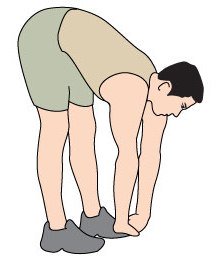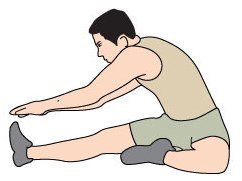Flexibility - Flexibility Exercises & Stretching Exercises for Flexibility Training
|
|
|
Flexibility Exercises are the key to a strong, flexible body
Discover the best Flexibility Exercises for a flexible body without aches and pains and strong muscles. Stretching exercises and workouts for a flexible body.
As you discovered in the Muscle and Fitness section that Flexibility is an integral part of fit body{ other two been muscular strength & endurance and Cardio fitness }. Being flexible not only helps prevent injuries and problems like back ache, it also improves muscular fitness and create excellent muscle balance.
Flexibility is an important component of a balanced fitness program. So don't skip it !
Inside this Flexibility Section
- What is Flexibility?
- Advantages of Flexible life - too many to miss!
- Test your Flexibility to measure results
- What factors affect Flexibility?
- Top 5 Flexibility Tips
- Type, Frequency, duration and intensity of stretching
- Stretching Exercises for Flexibility
- Additional Flexibility Resources
Flexibility is defined as the range of motion about a joint angle. Simple stated flexibility measures the range of motion and is primarily defined by the elasticity of the muscles and tendons attached to it.. Although weight training with full range of motion is helpful to improve flexibility, stretching are a must to develop flexibility.
Baring factors like your age, sex, muscle bulk and fitness status, anyone can improve on their present level of flexibility.
It is important o perform stretching exercises that target the primary joints of the body for complete flexibility.
Advantages of Flexible life - too many to miss!
In short flexibility improves your range of motion, reduces chances of injury, improves performance and posture, reduces stress, relaxes you and build a flexible, agile body.
1. Improved physical performance and reduced chance of injury
2. Improved posture and balance {More on Balance Exercises}
3. Improved muscle coordination and reduced low back pain.
4. Reduced Delayed Onset of Muscle Soreness and faster recovery!
Correcting posture - Flexibility stretches helps prevent extreme lordosis, kyphosis and scoliosis.
Don't forget to read How to maintain excellent posture section.
Performing flexibility exercises in your young days reduces the age-related loss in flexibility that occurs late in life.
Young people should take stretching very seriously.
Test your Flexibility to measure results
Testing how flexible is crucial for measuring progress in 2-4 weeks time as results will help you stay motivated. Remember nothing succeeds like success.
2 requisites before you test your flexibility
1. Proper warm up
2. Static Stretching
The flexibility test you do here is the simple sit-and-reach-test. It assesses flexibility in your lower back and hips.
What factors affect Flexibility?
1. Chronic posture resulting in muscle tension
2. Injuries
- Always stretch after a thorough warm up. Warm muscle responds better to stretching than cold ones. Remember stretching is NOT warm up.
- Stretching through a full range of motion is the best way to achieve a flexible body.
- Always stretch opposing muscle groups for balanced flexibility.
- Stretch to point of mild discomfort. Although stretching well within the range of motion will not add flexibility, you should always know when you are going beyond the injury-free zone.
- Do both a generalized stretching routine followed by a weight training specific or sports specific stretching routine always for a flexible and functional body.
What factors affect Flexibility?
Apart from Joint factors like the type of joint and its structure, major factors affecting flexibility are old age and female sex. These are less flexible than their counterparts generally.
Type, Frequency, duration and intensity of stretching AND Stretching Exercises for Flexibility
Please visit the Stretching Exercises Section for the above information.
Additional Flexibility Resources
ExerciseGoals.com Recommends - The Stretching Handbook.
|
135 Stretching & Flexibility Exercises. Take your Flexibility to the next level with Click here to find out more on The Stretching Handbook. |
|
-
Neck Rolls
-
Lunges/ Achilles Tendon Stretches
-
Hamstring Stretches -
Hurdler's Stretches,
Combination Hamstring Stretches
-
Side Bends,
Forward Bends,
Seated Forward Bends,
Standing Twists and
Windmills Exercise.
-
Core Stretches -
Lower Back Stabilizers/Erector Spinae Stretches.
-
Upper/Lower
Back Stretching Exercises.
-
Quadriceps Stretches,
Inner Thigh Stretches,
Hip Stretches.
-
Spinal Twists,
Hanging Stretches,
Abdominal Stretches.
-
High Knees Exercise,
Jumping in Place.
-
Cool Down Stretches.
Have A Great Stretching exercise or Workout?
Do you have a great story about this? Share it!
Common Workout and Weight Loss Diet Questions
It seems pretty much everywhere you go there are advertisements for weight loss and exercise products. That is because there are an alarming number of people who are overweight or obese and who need to lose weight. Here are some common questions people have when embarking upon a weigh loss journey about working out and dieting.
1. Do I need to stretch for flexibility?
Stretching is the best way to increase flexibility, but yoga and Pilates can also help with flexibility.
2. How to gain flexibility?
Becoming more flexible involves regular stretching. You have to stretch daily and stick to a schedule because increases in your flexibility will not be maximized without regular stretching. You should stretch every day. Short, daily stretching is better than one long stretching session each week. Your body needs routine to actually see flexibility results.
3. How to increase hamstring flexibility?
Tight hamstrings can lead to many injuries and pain. Stretching can increase flexibility. Stretches include a forward bend, single leg stretches up on a chair and a downward facing dog yoga pose. Any time you can feel the stretch in the hamstring you are working on improving the flexibility.
4. How do I build shoulder flexibility for overhead squats?
Some good stretches to help include the broomstick shoulder stretch, cross body stretch and shoulder circles. It is important to stretch everyday to get good flexibility gains.
5. How to improve flexibility after knee replacement?
The best stretches to help after knee replacement are those that stretch the hamstrings and the calves. Get your doctor's approval before beginning any stretching routine.
6. Three components of the body that are involved in your flexibility?
When you work on flexibility you are working the joints, bones and muscles since all three work together to affect how flexible your body is.
7. What exercises are a part of flexibility?
Flexibility exercises can be dynamic, static active or static passive. Exercises may include arm circles, bending stretches and using weights to stretch. Stretches can incorporate movement. You may use props like a chair or the wall to assist with stretches. Anything that works to lengthen the muscle and increase body movement can be included in flexibility exercises.
8. What is dynamic flexibility?
It is stretching done with movement, such as arm circles. This is the opposite of static stretching where you simply hold the stretch for a period of time with no movement.
9. Why is it important to have good flexibility?
Good flexibility helps to preserve range of motion in the joints, prevent injury and promote circulation. In older people, having good flexibility can prevent pain from arthritis and reduce the chance of falls and other balance related injuries. A flexible person will find general movements to be easier and will be less likely to be injured during physical activities.
10. Do you need flexibility for wrestling?
Flexibility is important to wrestling to help prevent injury and to help with proper balance. Muscles must be stretched and flexible or they are more susceptible to injury.
Go Back to Top of Flexibility Exercises Page
Go from Flexibility Exercises to Weight Training Homepage.







